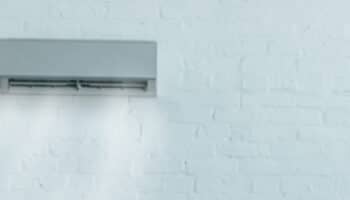Do you want to low your air conditioner bills, while making it more effective and longer-lasting?
Air conditioners are notorious for racking up high costs – especially throughout a hot summer. But many people are using the air conditioner totally wrong, or at least very inefficiently.
Below we’ve got every tip you need to make sure we get your air conditioner running costs down low, and keep it working well for a maximum amount of years.
We estimate that following this guide could save you up to $529!
We’ll delve into some general tips and then move forward to cover the specifics of different models, such as window, portable, ductless, and central ACs. I’m certain that, by the end of this guide, you’ll have a much clearer perspective on how to care for your appliance.
Ready to get started? Then let’s dive in.
Essential Air Conditioner Tips
These are our ‘essential tips’ – delivering the best bang for your buck in terms of lowering your energy bill and extending your AC’s lifespan.
#1 Take Other Measures to Keep Room Cool
This one might sound a little strange. After all, you bought the AC to keep the room cool without having to take other measures. But is it really a dealbreaker to add other cooling factors into the equation?
By taking additional steps to help your appliance cool your home, not only will you be keeping it from overtaxing itself, but also save a lot of money in the process! The average non-commercial central Air Conditioner consumes about 3500 watts per hour. This means that, if you use yours for about 4 hours a day, every day of the year, you’ll be consuming roughly 5,096 kWh yearly.
The average US price for electricity in 2023 is $0.1524 per kWh. So, running your AC for about 4 hours a day every day will run you about $777 per year. It might not sound like much, but if you have additional units or keep your appliance running for longer, the dollars start piling up.
By using additional cooling methods, you could decrease the yearly consumption of your Air Conditioner by up to 20%, representing hundreds, if not thousands of dollars over the years.
#2 Keep the Unit Away From Direct Sunlight
I know that you probably don’t keep your Air Conditioner in the garden next to the shed. But what if I told you that direct sunlight from a window could damage the unit nonetheless?
You see, like all other electronic appliances out there (aside from ovens and stoves, of course), AC units can overheat if exposed to high temperatures. These machines are designed to operate at certain internal temperatures while they’re on, so adding an external factor that increases said temperatures can be very problematic.
Solution: An Air Conditioner best practice is planning ahead of installing the unit. Make sure the appliance has enough breathing room to dissipate heat, while also being positioned away from windows, skylights, or sun tunnels.
If your AC is already installed, you can always get shaders to cover certain windows and keep the heat from the sun away.
#3 Don’t Crowd the AC
As mentioned earlier, you want to make sure that your Air Conditioner has enough breathing space. Contrary to popular belief, these appliances don’t cool a room by simply blowing cold air, in fact, they also depend on sucking in warm currents and dissipating the heat while recirculating them.
To achieve this, these appliances use what is known as condenser coils which is what allows them to send hot air outside and release pleasant cool breezes.
And while this all sounds great, it can be very easy to mess with this perfect balance by overcrowding the appliance. As it turns out, not unlike fridges, ovens, and freezers, Air Conditioners work best when they have enough breathing room.
Failing to provide it can make cooling inefficient, overworking this cooling solution while also drawing more power than normal.
Now, I’m not saying that you should only use them in empty rooms, not at all. Leaving 1 meter between the unit and every other object in a defined space is more than enough to keep things running smoothly.
#4 Clean the Filters and Condenser Coils in Spring
We’ve all heard the concept of “Spring cleaning” at one point or another. And while it’s a great custom, it’s also an undeniable necessity when trying to comply with Air Conditioner’s most effective best practices.
As I mentioned in the section above, in order to cool your room, your appliance works in a continuous process of air recirculation. It sucks in warm air from the environment, passes it through an evaporator coil, and then uses the condenser coils to blow the heat outside.
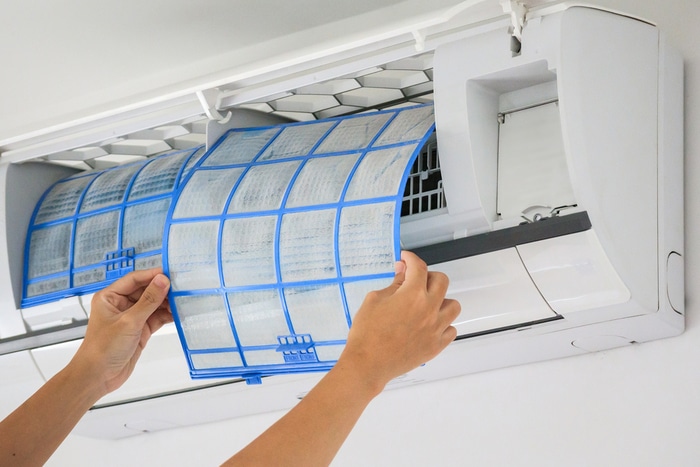
For both coil types, dust is the enemy year-round. However, during Spring there’s typically more pollen and unwanted airborne particles than normal, which can quickly decrease your unit’s cooling capacity.
Failing to clean your coils during this season can cause the appliance to overtax its components and force you to pay sky-high electricity bulls during the Summer. And for no good reason too!
Solution: Cleaning your condenser coils will take a little while, but once you’re done, your appliance should run much more efficiently. Here’s what you have to do:
- Kill the power to your AC and go outside, where the condenser coils are.
- Once you’re next to the external part of your appliance, unscrew the protective grid holding the fan motor in place.
- Once you can remove the grid, carefully place it along with the fan attached to it on the side of the unit, so you can have a clear view of your work area.
- Remove any dry leaves, dust, bugs, and other unwanted elements from the inside. If necessary, use a vacuum to get this done quicker.
- Inspect the aluminum fins on the inside of the unit. Minor bending is ok in some areas, but try your best to straighten anything that seems concerning.
- Use a coil cleaner, preferably foam-based (sold at most hardware stores), and spray it on the aluminum fins covering the surrounding area of the inside of the outdoor unit.
- Once you’ve covered every crevice, let the product sit for about 10–15 minutes.
- After this time has passed, use a hose (with low water pressure) and rinse off the coil cleaner foam from the inside out.
- Rinse the external part of the condenser coil unit as well.
- Place the fan and grid cover back into the unit and tighten the screws.
By removing dust and debris from your condenser coil unit, hot air will be thrown outside much more easily, and your wallet will definitely thank you.
Window AC Tips
Having covered our general tips, it’s time to move on to specific models, and what better way to start than with window variants? Below, you’ll find important information on how you can maximize efficiency and minimize wear and tear on these units.
#1 Ensure the Frame and Window Are Well Insulated
Effective cooling at lower power consumption depends greatly on one critical factor – proper insulation of every nook and cranny within your home.
If you live in a very humid and hot area (which you probably do, since otherwise you likely wouldn’t own an AC), then you might already know how big a difference insulation can make. In many cases, it can determine whether you’ll be cool and fresh at night, or rolling in the sheets covered in your own sweat!
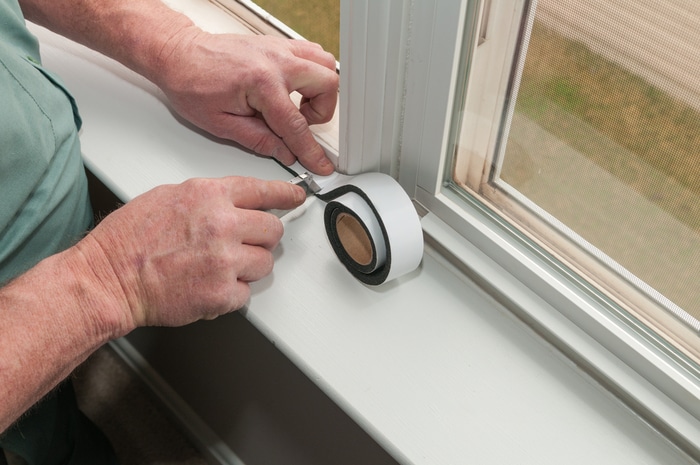
And this is exactly why making sure that there’s no outside air coming into your home and vice-versa is an Air Conditioner best practice.
Since these appliances work by recirculating air and dissipating heat, using them under steady and controlled temperatures will always yield the best results. By paying special attention to this element, your home will be cooled much more efficiently, saving you a considerable amount of money during sweltering days and nights.
Solution: There are many ways to check your window frame’s insulation. Some of my favorites are:
- Looking at the meeting point between the window frame and the wall when the sunlight is hitting the window. A properly insulated window should have no noticeable sunlight dots peeking through. If you do spot one or many, insulate the visible area and look again.
- On rainy days, you can run your fingers along the window frame and feel for dampness or even humidity seeping through.
- Carefully light a match next to the window and then blow it out. Use the smoke coming from it to look for air currents anywhere along the frame.
It might not seem like much, but even tiny non-insulated dots can force your window AC unit to work harder than it has to, so don’t put this off!
In the event that you need to remove the unit from your window and reinstall it properly, don’t worry. Doing it is very easy.
#2 Choose Non-sunny Windows
I know, I know. This is a window AC, so how are you going to keep the unit away from the sun?
Well… the answer lies in the cardinal points.
As you know, the sun rises in the East and sets in the West, which is something you can take advantage of. By choosing West-facing windows to place your AC, you’ll be keeping the appliance away from direct sunlight for most of the day.
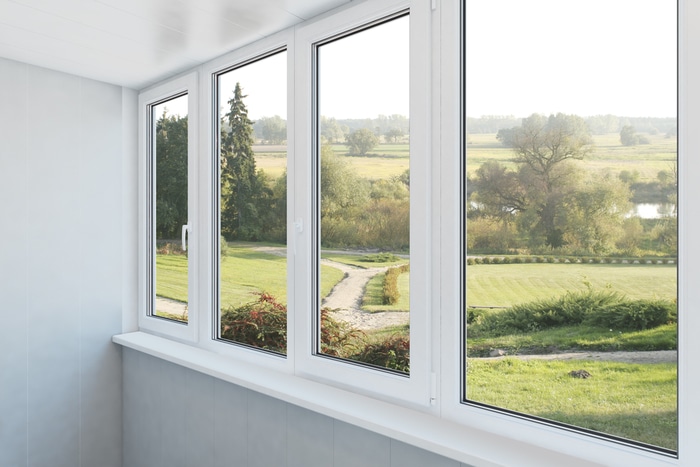
This is crucial, as constant direct sunlight can confuse your Air Conditioner, tricking it into working harder through “false information”. You see, within every one of these appliances, there’s a little component called a thermostat, which is responsible for sensing your room’s temperature in order to adjust your AC’s configuration.
In most cases, it detects temperature accurately, but when subjected to potent heat sources, such as sun rays, it can mistakenly sense higher-than-normal weather conditions, setting your appliance to full blast to make up for it.
Solution: If installing your Air Conditioner on West-facing windows is not on the table, you can also try installing a “shading mechanism” directly over the external side of the cooling unit. Something as simple as a small party tent can go a long way to keep sunlight away.
Just make sure you’re giving the appliance enough breathing room to run comfortably and dissipate the hot air it collects from inside your home.
Portable AC Tips
#1 Focus On Cooling the Room
It’s no secret that portable Air Conditioners are not as powerful as other variants, such as window or ductless models. But this does not mean that you have to sacrifice feeling cool and fresh if you own one.
In fact, you can get great results from your portable appliance by taking certain measures to maximize its efficiency. I know that the prospect of carrying your portable AC to every room you go to might not be the most appealing of ideas. But when you consider how much cheaper it is to buy and run, you might think differently.
The average portable AC unit consumes somewhere between 850–1250 watts per hour. So, if you keep yours running for about 4 hours every day, you’ll be using about 1,529 kWh per year (which is 3.33 times lower than the consumption for a central AC system).
Solution: The best way to maximize the cooling results from your portable AC unit is by making sure to keep the cool air recirculating within a designated area. To do this, you can check that all the doors and windows are closed and properly insulated.
It’s also a good idea to keep the appliance far from heat sources, such as ovens, windows with direct sunlight, or active portable heaters, since this, as you know, can make it overtax itself.
#2 Use Portability to Your Advantage
Depending on your living situation, this might be more or less of a possibility. Now that we’ve established how much cheaper these units are when compared to power hogs, like central cooling systems, it’s a good idea to evaluate whether you can cool your home by sticking only to portable models.
This is a viable Air Conditioner best practice when you only need to cool two rooms at the same time, as even in this situation, two portable units still consume less power than other cooling solutions.
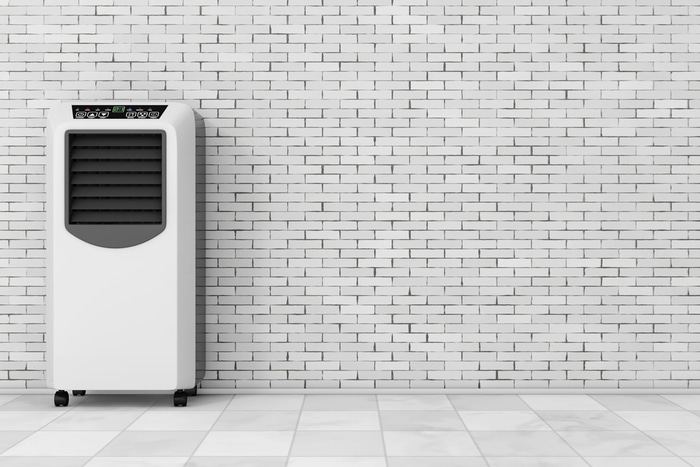
By using portability to your advantage, you can move your air conditioner wherever it’s needed, cooling only the rooms you’re actually in, rather than wasting power and money on cooling empty areas.
Again, I understand that moving this appliance around might not be comfortable for everyone. But if you don’t mind it and live with the right amount of people, two portable AC units could be a great way to maximize efficiency.
Note: I’ve set the maximum number of portable units to two, as using three or more brings diminishing returns in terms of power consumption when compared to central AC systems. If you think you’ll need 3 or more of these appliances, you’re better off turning to an alternative cooling solution.
Ductless AC Tips
Moving on, let’s now cover some of the most common AC units found in homes – ductless units. These are very effective at cooling households of all sizes by using effective heat dissipation and a convenient outdoor outlet.
Keep reading to find out how you can maximize efficiency in the long run!
#1 Keep It Running
This one will raise some eyebrows, as common sense would dictate that the less you use the appliance, the more power you’ll save, and the longer the unit will last. However, this is surprisingly not the case.
In fact, constantly turning your ductless Air Conditioner unit on and off requires much more power and effort than just keeping it on at all times. Granted, you don’t have to do this during the winter months, as you likely won’t need artificial cool air. But it’s one thing to turn the appliance off and not use it for 3 months, and a very different one to activate and deactivate it daily.
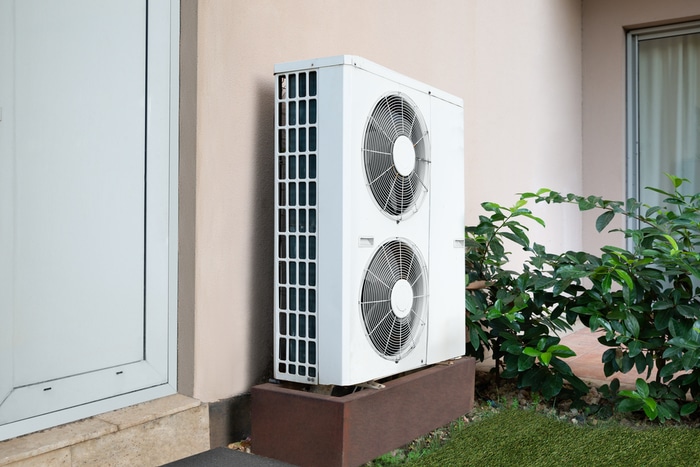
Just to give you a clearer idea of power consumption, the average central AC system uses about 2,000 watts per hour if all rooms are set to cool. This multiplied by 24 hours a day adds up to 48,000 watts, or 48 kWh daily. Over the course of a year, that number grows to 17,520 kWh, or $2,670.
I know this is a lot of money, but the amount pales in comparison to what you’ll be paying if you deactivate the cooling system often. The only way to cut costs while turning your ductless Air Conditioner during the day would be to use it for 8 hours per day or less. Anything over that will yield diminishing returns.
#2 Keep the Air Filter Clean
Next, let’s talk about proper maintenance and how it can affect the rate at which your appliance wears out and cools.
Keeping your air filters clean is an Air Conditioner best practice that every appliance owner should implement. As you might already know at this point, your cooling unit works by sucking up warm air from the environment to condense it and dissipate heat.
Once this process is completed, the hot air is blown outside through your cooling system’s exterior unit, and cool air is then recirculated in your room. If the air filters inside your Air Conditioner’s intake unit are dirty, airflow is highly affected, making the appliance have to work harder to suck in and blow out air.
This directly translates into higher electricity bills every month, and excessive wear and tear, which can eventually reduce the appliance’s lifespan unnecessarily.
Solution: To clean your air filters, please follow the simple steps below:
- If possible, cut the power supply to the room you’ll be working on.
- Turn the Air Conditioning unit off.
- Most models can be opened simply by lifting the front panel upwards (if your model has screws, carefully remove them to lift the front tab).
- You’ll immediately see the unit’s filters.
- Carefully remove them and place them somewhere to clean.
- Use a vacuum to delicately remove any debris and dust buildup from the filters.
- Repeat the process for all intake units in your home.
You should do this at least twice a year, if not more frequently.
#3 Keep the Fan in “Auto”
Yet another Air Conditioner best practice is letting your appliance work at its own pace rather than setting your own.
I understand how sometimes being in control of how things work can not only be satisfying but also relaxing. After all, the feeling like we’re in charge of things around us is a basic human trait. But what if I told you that keeping your Air Conditioner on “Auto” settings is the way to go?
Believe it or not, allowing your unit to take full control of how much it cools and how it adjusts its intensity accordingly, is one of the easiest ways to save money on utilities. As mentioned earlier, inside every Air Conditioner, there’s a small component called a thermostat, which senses room temperature.
By letting your appliance work as it sees fit, you’ll be ensuring cooler rooms at lower power draw. The best of both worlds.
#4 Optimize In-Home Airflow
As I mentioned a little earlier, proper insulation is key to guaranteeing maximum cooling efficiency while using your Air Conditioner. However, it’s one thing to keep your home’s environment isolated from the outside world, and a very different one to restrict airflow from within.
As you know, your ductless cooling system flows all throughout your home, communicating several areas with one another. By keeping doors closed, you’re unintentionally affecting your Air Conditioners’ potential for maximum efficiency, as the cool air is being trapped inside a specific area.
It’s always a good idea to optimize airflow within your home, as this will help your ductless Air Conditioner to cool larger spaces without so much effort.
I get this isn’t great for privacy, but a couple of hours a day is more than enough to get great results!
#5 Be Wary of Excessive Humidity
Last in this section is humidity and the dangers it poses. No one likes to come home to a musty, damp smell coming from the central air circulation system – it’s simply unpleasant.
However, there are other problems that can arise from excessive humidity other than a terrible experience for your nose. Conditions like these can not only be the perfect environment for the appearance of mold but also increase the power draw and effective cooling power of your appliance.
How so? Great question!
Humidity makes air naturally warmer, which, as you can imagine, is the opposite of what you’re looking for. When there’s an excess of it within your home, your Air Conditioner will have to work very hard to dissipate the heat, making your room feel a lot warmer, even at Max settings.

Solution: Depending on where you live, this might be easy to deal with, or extremely complicated. Provided you don’t live in swampy or tropical areas, a pellet dehumidifier, (sold at most hardware stores) should take care of the problem. They’re typically cheap and last for weeks.
Now, assuming that you do live in an area with high humidity, you might want to pick up a dehumidifying appliance to place in your dampest rooms. These units are not as cheap as their disposable pellet counterparts, but in the long run, they can save you a lot of money.
In fact, you can find great models from reputable brands for about $250. I know this sounds like a lot for something you didn’t even know that you needed, but I can guarantee that the unit will pay for itself in 12–18 months through your electricity savings.
Central AC Tips
Having covered most AC models, it is now time to end this guide by looking at some central Air Conditioner best practices. This last variant is one of the most efficient at-home cooling solutions, but sadly, it doesn’t come without elevated costs.
Here’s some useful information that will hopefully bring the utility bills down and increase your appliance’s lifespan.
#1 Choose the Right Size
First, let’s make sure that you’re using the right kind of central AC for the size of your home. A lot of people tend to mistakenly believe that any central Air Conditioning system will do the job, but this is not true.
After all, not all models are created equal.
Depending on how large your home is, you might need a unit with more or less capacity. There are many ways to calculate this, but my favorite one is to measure every room’s length and width and then multiply it by 25 BTUs (British thermal units). This formula should help you get closer to what you need for proper cooling, even on the most sweltering days.
But why is picking the right-sized central AC solution so important?
Well… mainly due to efficiency. While an Air Conditioning system with a larger capacity will draw more power at base settings than a smaller alternative, you should also take into account the intensity of operation.
If your appliance is too small to deliver the right results, you might find yourself turning the intensity all the way up to feel the cool breeze, whereas, with a larger unit, you can likely stay somewhere in the middle. More often than not, the latter scenario will mean less power drawn, and even more importantly, less stress on the appliance.
Solution: Ideally, the professional who installed your central AC system already accounted for this. But if you just moved to a new home or had the unit replaced, double-checking with the formula provided above is not a bad idea.
#2 Clean the Air Filters
Throughout this guide, we’ve covered in quite some depth how important it is to keep your air filters clean. At this point, you’ve likely already understood how often you should clean your appliance and the benefits it can carry, so I’ll keep this one short.
To maximize power efficiency, improve room cooling, and reduce wear and tear on your unit’s motor, fans, and other components, make sure to vacuum every one of your AC’s intakes at least twice a year, or more often if necessary.
#3 Tint Your Windows Where Possible
I bet that, when you started reading this guide, you never thought that sunlight could play such an important role in how your central Air Conditioning works. I get it, it’s not the most obvious thing to consider, but it’s an undeniable truth.
As I mentioned earlier, you’ll want to keep your appliance’s intake away from direct sunlight as this could mess with the thermostat inside it, making it hard to adjust the settings according to what’s needed.
However, this is not the only possible issue.

In many cases, the heat coming from sun rays impacting your window can heat up a room excessively. You’ve probably experienced this at some point, and you know it’s not at all pleasant. Events like this can cause your central Air Conditioner to work harder in order to cool a specific room, thus skyrocketing your utility bills every month, and overworking the appliance.
Solution: Tinting your windows is one of the quickest and most effective ways to prevent the heat from sun rays to turn your home into a sauna. There are many UV-proof films you can apply to your windows, and most of them should do a great job!
Furthermore, doing this will not only make your home naturally cooler, but also protect your flooring, walls, and most importantly, your skin. You can find several options at online marketplaces for less than $20, so if I were you, I’d get to it as soon as possible.
#4 Install Fluorescent Lightbulbs
This central Air Conditioner best practice will only come into play at night, but it can make a night and day difference (no pun intended).
If you were curious as a child, you likely burned your fingers at least once trying to touch a light bulb. It happened to the best of us, and it certainly taught us a valuable lesson. These days, there are many alternatives to the classic light bulb, and many of them are not only more power-efficient, but also a lot cooler.
Fluorescent light bulbs are a great example of this, as they are 4–6 times more efficient than their incandescent counterparts. This is a big difference when comparing single light bulbs, but it’s even more impressive when you think of the power you’ll save if you replace all the light bulbs in your home.
Moreover, fluorescent light bulbs radiate a fraction of the heat that incandescent ones do.
To put it into perspective, the average tungsten filament model heats up the metal to up to 4600 degrees Fahrenheit (ca. 2,538 °C)! And while this clearly won’t be the same heat that you’ll feel, several incandescent light bulbs in a room can increase its temperature greatly.
Solution: Fluorescent and LED light bulbs are a great alternative to their incandescent counterparts, and they’re not too expensive. I strongly recommend you look into installing these highly efficient, cool alternatives in your home to make your Air Conditioner’s job easier.
#5 Prefer Open Spaces
Lastly, let’s delve into your home’s decor. Now, I’m not an expert interior designer, so, sadly, I can’t help you make your living room look chic, but there’s some useful information I’d like to share with you.
Earlier in this guide, we discussed the importance of ensuring that airflow was optimized in every room so that your Air Conditioner intakes could achieve your desired temperature quicker. And while opening doors can, indeed, make cooling simpler, you should also take furniture and other obstacles into account.
Preferring open spaces in your living areas is not only great for making a room appear tidy and larger, but also to ensure the maximum degree of airflow. By rearranging areas like your living room and bedroom, you’ll be making your appliance’s cooling job much easier, as you’ll be minimizing air resistance.
Now, this isn’t an exact science, so you don’t have to spend the afternoon measuring and rearranging your futon placement. Little changes can go a long way in these cases, so just try your best to create an open path for your Air Conditioner’s current to flow.
Conclusion
That about covers it.
Air Conditioners are not cheap, and neither are the sky-high electricity bills that come hand in hand with them.
I hope these best practices have helped you better understand how to properly take care of your appliance to maximize its lifespan and save hundreds of dollars every year.
Thank you very much for sticking with me all the way to the end. If this article piqued your interest and provided useful information, please check out our other incredible resources below to keep the learning going.
On the site, you’ll find solutions for all sorts of everyday appliance issues, such as a range hood that’s blowing fuses, or a portable generator that’s not working.





